No More CAUTI: Preventing Catheter-Associated Urinary Tract Infections (May 5, 2015)
Slide Presentation
Slide 1
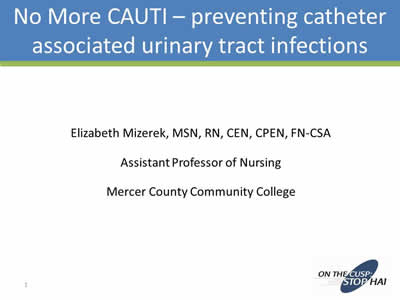
No More CAUTI - Preventing Catheter-Associated Urinary Tract Infections
Elizabeth Mizerek, MSN, RN, CEN, CPEN, FN-CSA
Assistant Professor of Nursing
Mercer County Community College
Slide 2

Learning Objectives
- Define the impact of CAUTI
- Describe decision making scenarios around catheter insertion indications
- Explain policies, procedures and insertion competencies
Slide 3

Insertion Indications
Slide 4
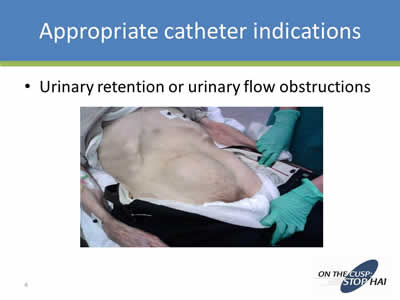
Appropriate Catheter Indications
- Urinary retentionor urinary flow obstructions
Image: Health professional starting catheter procedure on a patient.
Slide 5
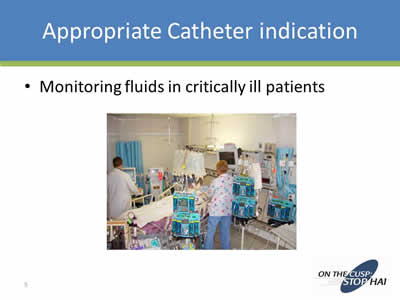
Appropriate Catheter Indication
- Monitoring fluids in critically ill patients
Image: Health professionals surrounding patient.
Slide 6
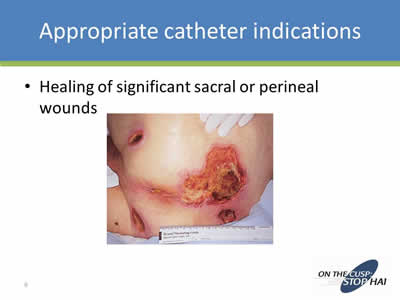
Appropriate Catheter Indications
- Healing of significant sacral of perineal wounds
Image: Image of a patient with serious perineal wounds.
Slide 7

Appropriate Catheter Indications
- Improving comfort at end of life.
Image: Photo of woman at bedside of patient holding hands with patient.
Slide 8
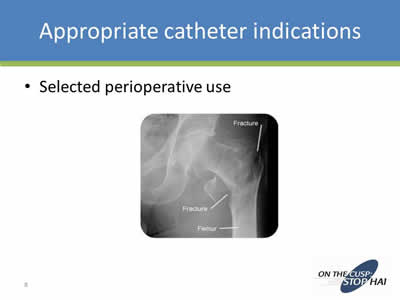
Appropriate Catheter Indications
- Selected perioperative use
Image: X-ray showing a hip with 2 fractures in it.
Slide 9
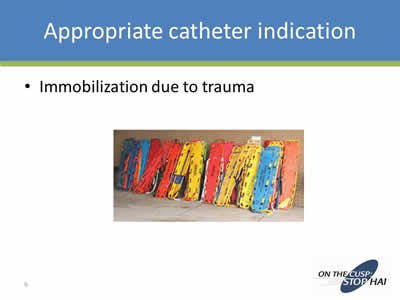
Appropriate Catheter Indication
- Immobilization due to trauma
Image: Photo showing a bunch of immobilization boards used during emergency transport.
Slide 10
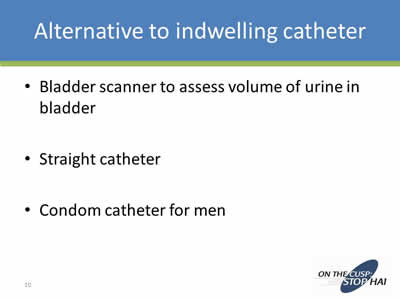
Alternative to Indwelling Catheter
- Bladder scanner to assess volume of urine in bladder
- Straight catheter
- Condom catheter for men
Slide 11
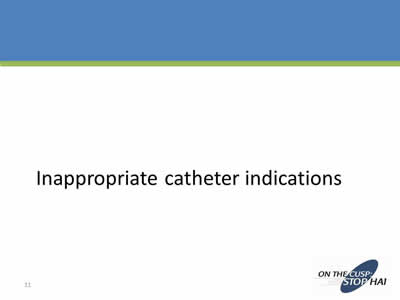
Inappropriate Catheter Indications
Slide 12
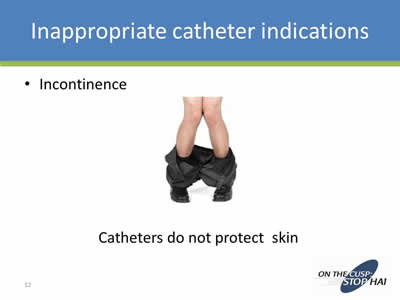
Inappropriate Catheter Indications
- Incontinence
Catheters do not protect skin
Image: Legs of a man with the pants pulled down to the shoes.
Slide 13
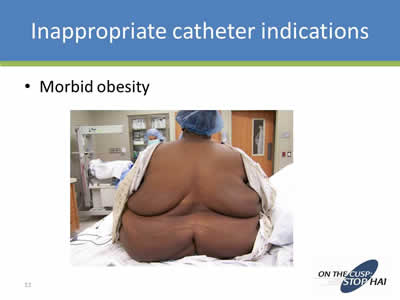
Inappropriate Catheter Indications
- Morbid obesity
Image: Back of a morbidly obese person.
Slide 14
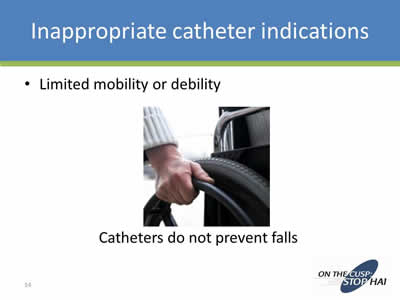
Inappropriate Catheter Indications
- Limited mobility or debility
Catheters do not prevent falls
Image: Hand pushing a wheelchair wheel.
Slide 15
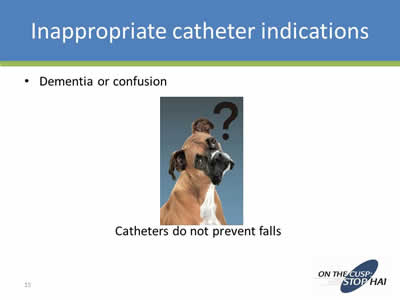
Inappropriate Catheter Indications
- Dementia or confusion
Catheters do not prevent falls
Image: Dog with a question mark over its' head.
Slide 16
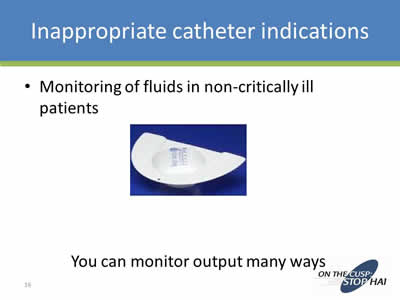
Inappropriate Catheter Indications
- Monitoring of fluids in non-critically ill patients
You can monitor output many ways
Image: Bedpan.
Slide 17
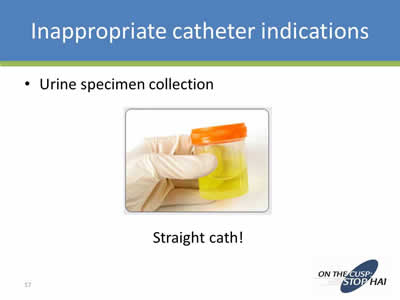
Inappropriate Catheter Indications
- Urine specimen collection
Straight cath!
Image: Hand holding a filled urine specimen container.
Slide 18
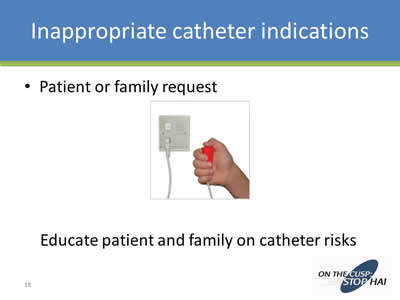
Inappropriate Catheter Indications
- Patient of family request
Educate patient and family on catheter risks
Image: Hand holding a nurse call bell and the outlet with a plug.
Slide 19
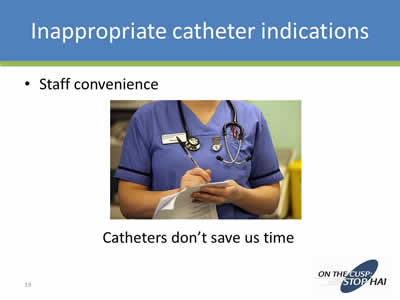
Inappropriate Catheter Indications
- Staff convenience
Catheters don't save time
Image: Health professional filling out information.
Slide 20

Decision Making Scenarios
Slide 21

Catheter or No Catheter?
Acute stroke patient with left sided weakness who is going to receive IV t-PA.
Image: Acute stroke patient with left-sided weakness.
Slide 22
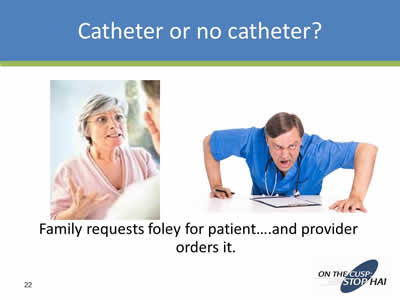
Catheter or No Catheter?
Family requests foley for patient….and provider orders it.
Images: Photo of woman talking to a doctor, and a doctor looking angry and demanding.
Slide 23
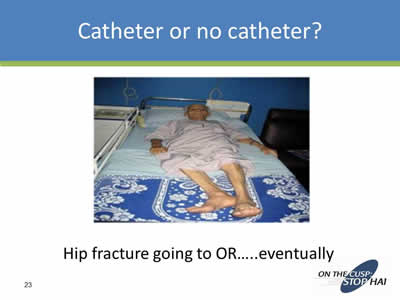
Catheter or No Catheter?
Hip fracture going to OR... eventually
Image: Elderly bedridden female patient.
Slide 24
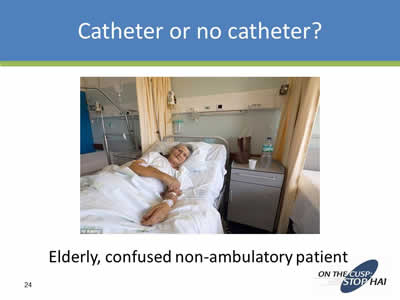
Catheter or No Catheter?
Elderly, confused, non-ambulatory patient
Image: Elderly bedridden female patient.
Slide 25
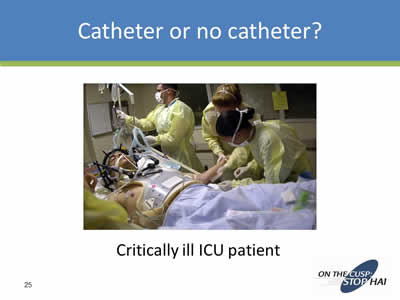
Catheter or No Catheter?
Critically ill ICU patient
Image: Trauma patient being treated by a number of health professionals.
Slide 26
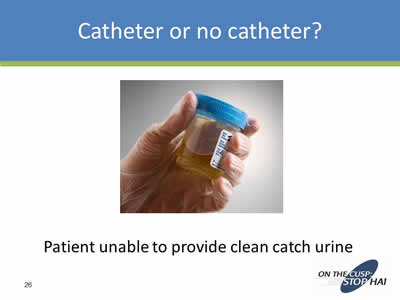
Catheter or No Catheter?
Patient unable to provide clean catch urine
Image: Hand holding a filled urine specimen container.
Slide 27
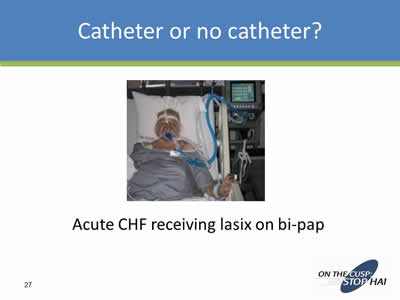
Catheter or No Catheter?
Acute CHF receiving lasix on bi-pap
Image: Photo of patient with a bi-pap machine
Slide 28

Demonstrated Competency
Slide 29
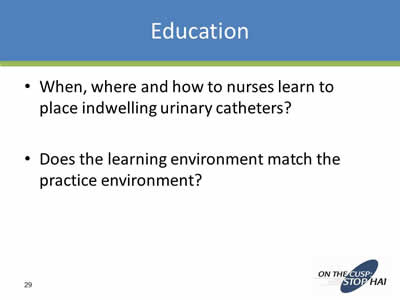
Education
- When, where and how to nurses learn to place indwelling urinary catheters?
- Does the learning environment match the practice environment?
Slide 30
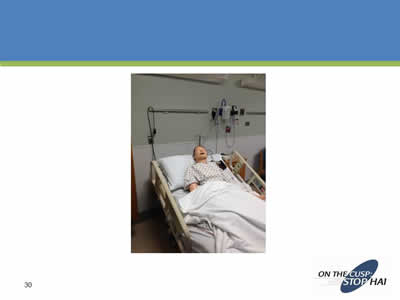
Image: Simulation dummy patient
Slide 31
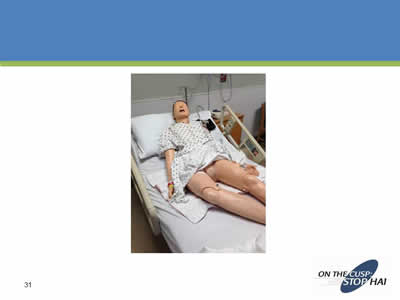
Image: Simulation dummy patient
Slide 32
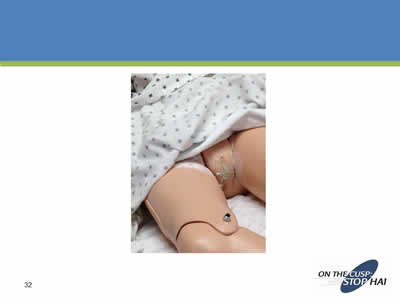
Image: Close-up image of crotch area of simulation dummy showing the area as "soiled".
Slide 33
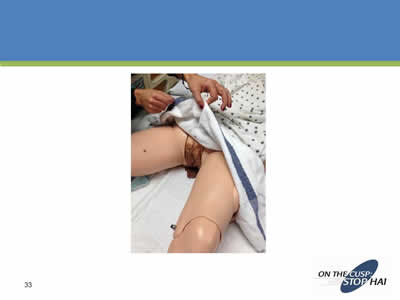
Image: Close-up image of crotch area of simulation dummy showing the area as "soiled".
Slide 34
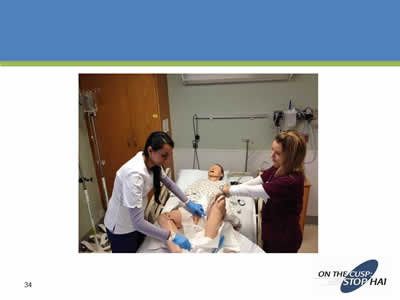
Image: Students practicing urinary catheter insertions using simulation dummy.
Slide 35

Some Additional Thoughts...
Slide 36

Teamwork
- Shared mental model – trained nurses and techs together
- Teamwork to facilitate placement
- Empowered all staff to speak up when breach of sterile technique noted – patient safety!
Slide 37
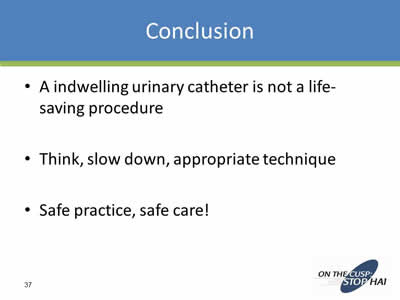
Conclusion
- A indwelling urinary catheter is not a life-saving procedure
- Think, slow down, appropriate technique
- Safe practice, safe care!
Slide 38

Thank you!
Questions?
Slide 39

Funding
Prepared by the Health Research & Educational Trust of the American Hospital Association with contract funding provided by the Agency for Healthcare Research and Quality through the contract, “National Implementation of Comprehensive Unit-based Safety Program (CUSP) to Reduce Catheter-Associated Urinary Tract Infection (CAUTI), project number HHSA290201000025I/HHSA29032001T, Task Order #1.”
Return to CAUTI Toolkit Information for Specialty Audiences



